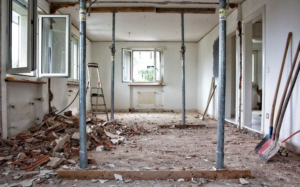As architectural techniques continue to evolve, ensuring the safety and protection of our homes becomes paramount. Fachwerkhäuser, or half-timbered houses, with their distinctive exposed wooden frames, are not only charming but also require unique strategies for enhanced fire protection. That’s why, at this moment, let’s learn some effective methods for safeguarding these beautiful structures against the devastating effects of fires.
Compartmentalization

Compartmentalization is a key architectural technique when it comes to fire-proofing half-timbered houses. By dividing the house into separate compartments or zones, we can contain the spread of fire and limit its potential damage.
One way to achieve compartmentalization is by installing fire-resistant walls and partitions between different areas of the house. These walls act as barriers, preventing flames from easily spreading throughout the entire structure. Additionally, using materials with high fire resistance properties, such as gypsum boards, can further enhance this protective measure.
Strategic Placement of Firebreaks
 Firebreaks are essentially gaps or barriers designed to prevent the spread of fire from one area to another. In the context of half-timbered houses, these breaks can be strategically placed throughout the structure to minimize the risk and impact of fire incidents. That’s why many architects often also create physical barriers between different parts of the house.
Firebreaks are essentially gaps or barriers designed to prevent the spread of fire from one area to another. In the context of half-timbered houses, these breaks can be strategically placed throughout the structure to minimize the risk and impact of fire incidents. That’s why many architects often also create physical barriers between different parts of the house.
This can be achieved by incorporating non-combustible materials such as brick, stone, or concrete into specific areas like walls or floors. These materials act as a buffer zone that hinders flames from leaping across sections and engulfing the entire building. Additionally, structural elements within half-timbered houses can also serve as effective firebreaks.
Incorporation of Passive Fire Protection
This protection is all about the use of materials and techniques that can slow down the spread of fire and protect the structural integrity of a building. We often call these non-combustible or flame-resistant materials. This includes using fire-resistant insulation, such as mineral wool or fiberglass, which can help prevent flames from spreading through walls or floors.
Another effective method is installing fire-rated doors and windows. These are designed to resist the passage of flames and heat for a certain period, giving occupants more time to escape safely. Properly sealing gaps around pipes, electrical wires, and other openings is also essential in preventing the spread of flames. Fire-resistant sealants or caulks should be used to seal these gaps effectively.
Optimized Egress Design

In the event of a fire, having a well-planned and efficient means of escape can make all the difference in saving lives. It’s essential to have multiple exits strategically located throughout the house, ensuring that occupants have easy access to them from any point within the building. These exits should be wide enough to accommodate quick and orderly evacuation, even if individuals are panicking or carrying personal belongings.
Furthermore, staircases play a vital role in egress design. Stairs should be easily accessible from every part of the house and constructed using fire-resistant materials like concrete or metal. Handrails must also be installed for support during evacuation efforts. Incorporating wider hallways can greatly facilitate movement through the building during an emergency situation.
While no building can be completely immune to fires, employing these architectural techniques greatly improves both prevention and response capabilities. It is crucial for homeowners and architects alike to prioritize fire-proofing measures in order to protect not only lives but also our rich cultural heritage.
